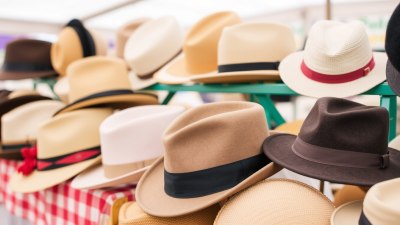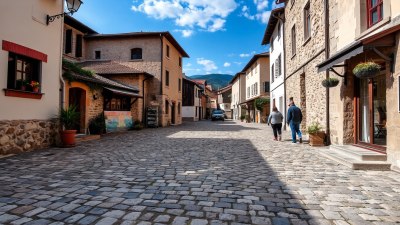Building a Collection of Local Vintage Hats from Markets
Discover how to curate a stunning collection of vintage hats from local markets with tips and strategies.

Image created with Flux Schnell
Curating a collection of vintage hats can be an exciting and rewarding hobby. Whether you're a fashion enthusiast, a collector, or simply someone who enjoys unique accessories, vintage hats have a charm that can enhance any outfit. This article will provide you with essential tips on how to build your collection from local markets.
The Allure of Vintage Hats
Vintage hats are not just accessories; they are pieces of history. Each hat tells a story, whether it’s a feathery fascinator from the 1920s or a sturdy felt fedora from the 60s. Collecting these hats isn’t merely about owning them; it’s about appreciating the craftsmanship, the style, and the era they belong to. They can serve as conversation starters, fashion statements, or even investment pieces.
Why Local Markets?
Local markets are treasure troves for vintage hats. Unlike mainstream retail stores, these markets offer a more unique and diverse selection. You’re likely to discover items that aren't available online or in typical boutiques. Moreover, shopping at local markets supports small businesses and enhances community engagement.
Researching Local Markets
Before you dive into your hat-hunting adventure, research the local markets in your area. Look for flea markets, antique fairs, and vintage shops. Some areas have designated days for specialized markets, like vintage or retro themes. Use social media and community boards to find out when and where these markets occur. Don’t forget to check reviews and ask locals for recommendations to pinpoint the best spots.
Know What You’re Looking For
Having a clear idea of the style of hats you want to collect can help streamline your search. Vintage hats come in varying styles—berets, bowlers, sun hats, and more. Familiarize yourself with different vintage eras and their styles. Research hat designers like Stetson, Borsalino, and others that have made significant contributions to hat fashion. This knowledge will inform your purchases and make you a more educated collector.
Inspecting Vintage Hats
When you find a potential hat, take the time to inspect it thoroughly. Look for signs of wear, such as stains, tears, or discoloration. Check the lining and stitching to see how well the hat is constructed. Vintage hats often have unique features like decorative bands or custom fittings. Use your findings to negotiate a fair price with the vendor.
Negotiation Tips
When purchasing at local markets, don’t shy away from negotiating the price. Vendors often expect haggling, so be polite yet assertive. Start by offering a lower price and justify it with your observations about the hat's condition. Be respectful of the vendor’s effort and craftsmanship; often, a good conversation can lead to a better deal.
Caring for Your Vintage Hats
Once you've successfully added a vintage hat to your collection, it's essential to care for it to prolong its life. Store hats in a dry, cool place away from direct sunlight to avoid fading. Use hat boxes for delicate styles to maintain their shape. Regularly clean them according to the materials used; wool, felt, and straw hats each require different care methods. For a deep cleaning, consider professional hat cleaning services, especially for fragile items.
Displaying Your Collection
Once you have accumulated a few vintage hats, displaying them can be part of the fun. Consider creating a dedicated wall space with hooks or a glass display case. Head mannequins are another stylish option, allowing you to showcase the hats while adding an interesting decor element to your home. Ensure to protect your hats from dust and too much sunlight.
Connecting with Fellow Collectors
Finding a community of fellow vintage hat collectors can greatly enhance your experience. Look for online forums, social media groups, or local clubs focused on vintage fashion. Being part of a community allows you to share tips, trade hats, and attend events together. Some collectors even organize meetups or trading days, which can be an excellent opportunity to expand your collection.
The Thrill of the Hunt
The process of hunting for vintage hats is part of the thrill. Each market visit can yield unexpected finds—sometimes a hat that captures your heart isn’t what you initially envisioned seeking. Embrace the journey; it’s not only about building a collection but about the stories and experiences you gather along the way.
Consider Sustainability
Collecting vintage hats is also an environmentally friendly choice. By purchasing secondhand items, you are contributing to sustainable fashion practices. It helps reduce waste and promotes the reuse of beautiful, well-crafted items. This is particularly relevant in today’s consumer culture, where fast fashion contributes significantly to environmental degradation.
Documenting Your Collection
As your collection grows, consider documenting each piece. Note down where and when you acquired each hat and any interesting stories associated with them. Taking photos can also help you keep track of your collection. You might even consider starting a blog or social media account dedicated to your vintage hat collection; this not only preserves your memories but also inspires others to appreciate vintage fashion.
Why Vintage Hats Matter
In conclusion, building a collection of vintage hats from local markets is not just a hobby; it’s a way to celebrate history, fashion, and sustainability. Each hat carries within it the lives and stories of people who wore it before you. Embrace the charming uniqueness of each piece you collect. Remember to enjoy the process, as every market visit can lead to delightful surprises. Happy collecting!











